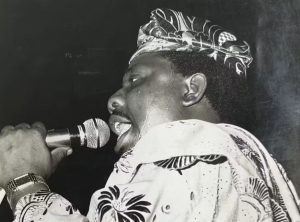|
Getting your Trinity Audio player ready...
|

Saheed Aderinto, Florida International University
Nigerian singer Síkírù Àyìndé Barrister (1948-2010) pioneered fújì, a Yorùbá genre of popular dance music. In February 2024, historian Saheed Aderinto’s documentary on the musician’s life and times premiered. The Conversation Africa’s Wale Fatade asked Aderinto about the film and the music it brings to our attention.
What is fújì music?
Fújì fuses Islamic philosophy and wordsmithing with Yoruba poetry and meaning-making to create sound, idioms and recreational habits. It does this across social classes, from the wealthy in the corridors of political power to the poor at the fringe. Its messages, politics, performance styles, space and sophistication reflect a wide range of realities.
However, fújì did not begin as a secular and commercial sound. Its musical ancestor, wéré, was a seasonal Islamic performance during Ramadan. Wéré’s origin dates to the 19th century or earlier when Islam established firm roots among the Yoruba. The Yoruba are one of the numerous ethnic groups in Nigeria.
From the early 1970s, Ayinde Barrister began to expand the domain of wéré’s performance. He turned it into an all-year-round commercial secular music drawing from established secular forms. By the mid-1970s, fújì emerged as a distinct genre through his pioneering efforts. He combined numerous elements of existing music, such as sakara, apala, juju and Afrobeat, to create a hybrid sound that also borrowed from Yoruba aesthetics of praise singing.
By the mid-1980s, fújì was a staple in the Nigerian soundscape. As the 20th century eclipsed, it was one of the most dominant popular music styles across the African diaspora.
Today, fújì exhibits all the conventional elements of global entertainment music. Its beat-making, computer-based production technology, new electronic and digital circulations, and eclectic performativity all align with similar global forms such as Afrobeats. And fújì is not immune to common criticisms of popular music: sexualising women, portraying unrealistic notions of socio-economic mobility, and promoting obnoxious ideals of self-making.
How does it live on in Nigeria today?
Today, fújì is the most dominant of the Yoruba musical traditions. A large number of professional singers self-identify as fújì artists and perform the genre in its identifiable form. It has overtaken all other Yoruba forms and even influenced contemporary Afrobeats. For example, Afrobeats artist Olamide’s song Omo Anifowose is deeply influenced by K1 de Ultimate’s song of the same name.
From big parties in African diaspora communities in Europe and North America to obscure events in the inner city of Ibadan, fújì is a central musical form.
Musicians range from the sophistication of Kollington Ayinla, K1 de Ultimate and Sefiu Alao Adekunle (Baba Oko), among others, to aspiring artists like Muta Jero of Bodija in Ibadan. Fújì draws fans and practitioners not only because of its flexible playing styles, but also because the sound, message and performance connect with people’s everyday realities.
Fújì is how people remember their family stories.
The global audience of the documentary can easily connect with issues that cross cultures, such as the religious origins of the music, the grass-to-grace stories of superstars, love, gender and erotic passion. Similarly, trials, triumphs and tribulations, forgiveness and reconciliation, public politics and protest art, creativity, global travels, fandom and stardom, self-making and identity construction, sickness, death and immortality. It is fújì’s transculturality, which doesn’t lose sight of specific historical and cultural contexts, that fascinates me.
Why did you choose the story of Sikiru Ayinde Barrister?
He pioneered the genre. It’s logical for the first episode of The Fuji Documentary to focus on him. He dominated and defined fújì sound and performance. Even his politics was the most sophisticated. This changed from preaching against bad democratic leadership in 1983, to supporting the military incursion into Nigerian politics in 1984, to protesting against military dictatorship in the 1990s, and extolling democratic principles in the first decade of the 21st century.
His albums such as Nigeria (1983); Military (1984); Current Affairs (1989); The Truth (1994); Precaution (1995); Adieu MKO Abiola (1998); and Democracy (1999) combine all the elements of political theorisations that we find in some of the best works on African politics.
Unlike other musicians who mostly commented on public politics, Ayinde Barrister turned fújì into a political ideology. He did this by creatively tapping into indigenous perspectives on politics to speak to the 20th century crisis of political leadership in Nigeria.
The Fuji Documentary, First Episode: Mr Fuji: Barry Wonder.
What do you want viewers to take from the documentary?
Fújì is more than sound. It’s a way of life for millions of Yoruba people. It’s how they see the world around them.
The first episode preserves the legacies of Barrister through the medium of a film. It connects the public with university-level research or allows academic research to serve public interest. It creates knowledge in new ways and shapes how people remember the past. The Fújì Documentary takes the name of fújì into academic domains where it didn’t exist until now.
To shoot the documentary in public libraries, cultural centres, galleries, art theatres, museums and facilities on university campuses, I wrote formal letters and lobbied to convince people that the story is a collective story that everyone should own. Allowing people to own a narrative doesn’t necessarily mean they are familiar with the narrative — it’s connecting that narrative to what they are familiar with.
When I look at the array of people involved in this first episode, I come to realise that what makes a history public history is not just telling a story that the public can relate to in an accessible manner, but also getting the public to be part of the creation and to own the process.
And the public in this sense is not just one public, but multiple publics who don’t necessarily share the same perspectives about anything. Bringing these multiple publics together to create a single public for the documentary is an unending process.![]()
Saheed Aderinto, Professor of History and African and African Diaspora Studies, Florida International University
This article is republished from The Conversation under a Creative Commons license. Read the original article.





